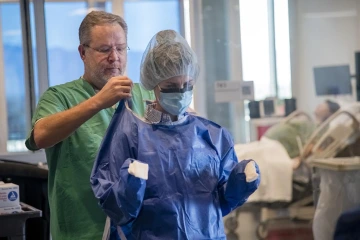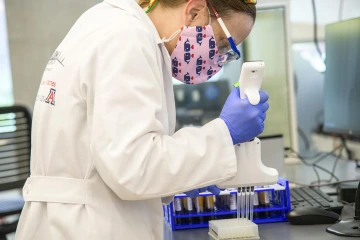Health Sciences Students Analyze COVID-19 Published Research
The College of Medicine – Phoenix is helping evaluate the quality of the research being released rapidly about the virus that causes COVID-19.

Research into COVID-19 tests, treatments and practices is widespread and varied. A team at the College of Medicine – Phoenix is developing a system for understanding the research underway.
To help health care providers and policy makers better understand the immense amount of coronavirus research being released daily, health care volunteers are evaluating the quality of the articles and distilling the information into a manageable format.

Erin Hartnett is one of the first two members of the COVID-19 Literature Surveillance Team.
“The COVID-19 LST is a professional group of affiliated volunteers from across a variety of disciplines and under the guidance of physicians who have been brought together by one mission: to help increase situational awareness, while informing frontline healthcare providers and key decision makers,” said Erin Hartnett, a fourth-year medical student at the College of Medicine – Phoenix. “Many medical students have been sidelined by the pandemic and are looking for ways to contribute to the response.”
The team grew from two contributors, Hartnett and Rah, in early April to now more than 30 contributors. Hartnett is among the 23 students at the College of Medicine – Phoenix who are involved with the COVID-19 LST. Other collaborators are associated with the College of Medicine – Tucson, University of Washington, Western University of Health Sciences, United States Air Force and Bernhard Nocht Institute for Tropical Medicine in Hamburg, Germany.

Health care workers don personal protective equipment, known as PPE, before treating patients with the virus that causes COVID-19. Some research conducted during the pandemic included efficacy of PPE to protect against the virus’ spread.
The COVID-19 LST conducts ongoing reviews and posts the results to its website. Their reports are shared across all sectors of the COVID-19 response, including medical schools and facilities in the U.S., as well as in Europe and Canada. They are also used by government agencies, such as in the U.S. Army by Col. Will Smith, MD, one of the co-founders of the project.
The team uses the five-level Oxford Centre for Evidence-based Medicine Levels of Evidence descriptions to evaluate the quality of articles. However, they have taken it a step further by adding a sixth level for articles that do not cite any data. “We found this was necessary because many publications have suspended peer review, which means research is getting published and distributed without properly being vetted,” Hartnett said.

Research is being rapidly released about the virus that causes COVID-19, antibody detection and possible treatments.
Hartnett said there are a number of “predatory journals” where people pay a hefty fee and can publish anything they want regardless of evidence. “This is posing an increasing threat to the response and the scientific narrative surrounding the pandemic,” Hartnett said. “By critiquing levels of evidence, we hope to mitigate some of these effects.”
“The most surprising things have been the breadth of research being conducted now and the quality of the research published,” Hartnett said. “We have seen noticeable trends of improving research quality since the start of the pandemic. Even a couple weeks ago, we often saw articles that seemed to focus more on speculation or possible research directions as opposed to proven data with good quality evidence.”

